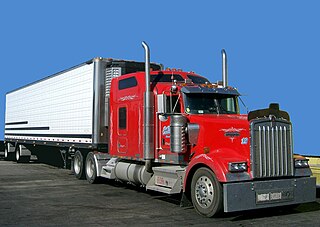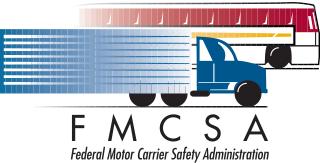
A commercial driver's license (CDL) is a driver's license required in the United States to operate large and heavy vehicles or a vehicle of any size that transports hazardous materials or more than 15 passengers.
The Driver License Compact is an agreement between states in the United States of America. The compact is used to exchange data between motorist's home state and a state where the motorist incurred a vehicular violation. Not all states are members, and states respond to the data differently.
In the United States, the Driver License Agreement (DLA) is an interstate compact written by the Joint Executive Board of the Driver License Compact (DLC) and the Non-Resident Violator Compact (NRVC) with staff support provided by the American Association of Motor Vehicle Administrators (AAMVA). The DLA requires all states to honor licenses issued by other member states, report traffic convictions to the licensing state, prohibit a member state from confiscating an out-of-state driver's license or jailing an out-of-state driver for a minor violation; and maintain a complete driver's history, including withdrawals and traffic convictions including those committed in non-DLA states.
The American Association of Motor Vehicle Administrators (AAMVA) is a non-governmental, voluntary, tax-exempt, nonprofit educational association. AAMVA is a private corporation which strives to develop model programs in motor vehicle administration, police traffic services, and highway safety.

The Real ID Act of 2005 is an Act of Congress that establishes requirements that driver licenses and identification cards issued by U.S. states and territories must satisfy to be accepted for accessing federal government facilities, nuclear power plants, and for boarding airline flights in the United States. The requirements include verification of the personal information presented when applying for the identification document, security features on the document, and electronic sharing of databases between states. The act also made various modifications to U.S. immigration law regarding asylum, border security, deportation, and specific work visas.
In the United States, identity documents are typically the regional state-issued driver's license or identity card, while also the Social Security card and the United States passport card may serve as national identification. The United States passport itself also may serve as identification. There is, however, no official "national identity card" in the United States, in the sense that there is no federal agency with nationwide jurisdiction that directly issues an identity document to all US citizens for mandatory regular use.
The National Driver Register (NDR) is a computerized database of information about United States drivers who have had their driver's licenses revoked or suspended, or who have been convicted of serious traffic violations, such as driving under the influence or drugs or alcohol.. The records are added and maintained and deleted by the motor vehicle agency (MVA) of the state that convicted the driver or withdrew the driver's license.

An International Driving Permit (IDP), often referred to as an international driving license, is a translation of a domestic driving license that allows the holder to drive a private motor vehicle in any country or jurisdiction that recognises the document. The term International Driving Permit was first mentioned in the document prescribed in the International Convention relative to Motor Traffic that was signed at Paris in 1926, and is a translation of the French 'permis de conduire international', or 'international driving license'. The Paris treaty, and all subsequent, use the word 'permit' exclusively in relation to all kinds of driving license.

The Federal Motor Carrier Safety Administration (FMCSA) is an agency in the United States Department of Transportation that regulates the trucking industry in the United States. The primary mission of the FMCSA is to reduce crashes, injuries, and fatalities involving large trucks and buses.

The Oklahoma Department of Public Safety (ODPS) is a department of the government of Oklahoma. Under the supervision of the Oklahoma Secretary of Public Safety, DPS provides for the safety of Oklahomans and the administration of justice in the state. DPS is responsible for statewide law enforcement, vehicle regulation, homeland security and such other duties as the Governor of Oklahoma may proscribe.

The Oklahoma State Bureau of Investigation (OSBI) is an independent state law enforcement agency of the government of Oklahoma. The OSBI assists the county sheriff offices and city police departments of the state, and works independent of the Oklahoma Department of Public Safety to investigate criminal law violations within the state at the request of statutory authorized requesters. The OSBI was created in 1925 during the term of Governor Martin E. Trapp.

The California Department of Motor Vehicles (DMV) is the state agency that registers motor vehicles and boats and issues driver licenses in the U.S. state of California. It regulates new car dealers, commercial cargo carriers, private driving schools, and private traffic schools. The DMV works with the superior courts of California to promptly record convictions against driver licenses, and initiates administrative proceedings before its own administrative law judges to suspend or revoke licenses when drivers accumulate excessive convictions. It issues California license plates and driver's licenses. The DMV also issues identification cards to people who request one.
Truck classifications are typically based upon the maximum loaded weight of the truck, typically using the gross vehicle weight rating (GVWR) and sometimes also the gross trailer weight rating (GTWR), and can vary among jurisdictions.

Commercial driver's license training is a specialized instructional program or course designed to prepare a student to obtain a commercial driver's license (CDL), which is required for a career as a truck driver in the United States. During training, students are taught the necessary knowledge and skills to pass a series of tests to obtain their CDL. Such a program generally begins with classroom instruction geared towards passing the written exams for a CDL permit, a learner's permit that allows a student to practice driving skills on public roads with a CDL licensed driver or instructor. Students graduate from CDL training upon receiving their CDLs and proving that they can comfortably and safely drive and maneuver a truck. Most CDL training schools train drivers for a class A CDL, which allows the holder to drive a tractor trailer weighing over 26,000 pounds. Some CDL training schools incorporate truck driving simulators into their curriculum to help student drivers learn the basics of driving a truck — including shifting gears, braking, and parking.

In the United States, driver's licenses are issued by each individual state, territory, and the District of Columbia. Drivers are normally required to obtain a license from their state of residence. All states of the United States and provinces and territories of Canada recognize each other's licenses for non-resident age requirements. There are also licenses for motorcycle use. Generally, a minimum age of 15 is required to apply for a non-commercial driver license, and 25 for commercial licenses which drivers must have to operate vehicles that are too heavy for a non-commercial licensed driver or vehicles with at least 16 passengers or containing hazardous materials that require placards. A state may also suspend an individual's driving privilege within its borders for traffic violations. Many states share a common system of license classes, with some exceptions, e.g. commercial license classes are standardized by federal regulation at 49 CFR 383. Many driving permits and ID cards display small digits next to each data field. This is required by the American Association of Motor Vehicle Administrators' design standard and has been adopted by many US states. The AAMVA provides a standard for the design of driving permits and identification cards issued by its member jurisdictions, which include all 50 US states, the District of Columbia, and Canadian territories and provinces. The newest card design standard released is the 2020 AAMVA DL/ID Card Design Standard (CDS). The AAMVA standard generally follows part 1 and part 2 of ISO/IEC 18013-1. The ISO standard in turn specifies requirements for a card that is aligned with the UN Conventions on Road Traffic, namely the Geneva Convention on Road Traffic and the Vienna Convention on Road Traffic.

The Vermont Department of Motor Vehicles (DMV) is the governmental agency responsible for registering and inspecting automobiles and other motor vehicles as well as licensing drivers in the U.S. state of Vermont.
Criminal records in the United States contain records of arrests, criminal charges and the disposition of those charges. Criminal records are compiled and updated on local, state, and federal levels by government agencies, most often law enforcement agencies. Their primary purpose is to present a comprehensive criminal history for a specific individual.

A driver's license, driving licence, or driving permit is a legal authorization, or the official document confirming such an authorization, for a specific individual to operate one or more types of motorized vehicles—such as motorcycles, cars, trucks, or buses—on a public road. Such licenses are often plastic and the size of a credit card.
A Lebanese driving licence is a driving licence issued by the government of Lebanon. It authorises its holder to operate various types of motor vehicles on highways and some other publicly accessible roads. It is issued by each individual district.
The term digital card can refer to a physical item, such as a memory card on a camera, or, increasingly since 2017, to the digital content hosted as a virtual card or cloud card, as a digital virtual representation of a physical card. They share a common purpose: identity management, credit card, debit card or driver's license. A non-physical digital card, unlike a magnetic stripe card, can emulate (imitate) any kind of card.